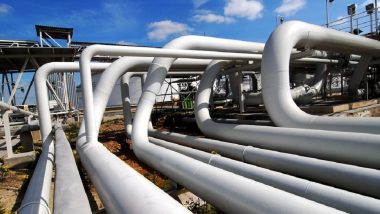Moscow, December 2: Russia and China on Monday launched a giant gas pipeline linking the countries for the first time, one of three major projects aimed at cementing Moscow's role as the world's top gas exporter.
Presiding by video link-up over an elaborate televised ceremony, Russian leader Vladimir Putin and Chinese counterpart Xi Jinping hailed the "Power of Siberia" pipeline as a symbol of cooperation.
"Today is remarkable, a truly historic event not only for the global energy market, but first of all for us and for you, for Russia and China," Putin said.
Xi said the project served as a model of cooperation and that "the development of Sino-Russian ties is and will be a foreign policy priority for both our nations".
The ceremony featured hard-hatted gas workers and videos showing the pipeline's difficult path from remote areas of eastern Siberia to Blagoveshchensk on the Chinese border.
Workers burst into applause and celebratory music played as the CEO of Russian gas giant Gazprom, Alexei Miller, ordered a valve opened for the gas to pass across the border.
- 'World's biggest construction project' -
The 3,000-kilometre (1,850-mile) pipeline -- which Putin has called "the world's biggest construction project" -- will supply China with 38 billion cubic metres (1.3 trillion cubic feet) of gas annually when it is fully operational in 2025.
Russia and China signed a 30-year, $400 billion deal for its development in 2014, in the biggest ever contract for Gazprom.
Gazprom stressed that the pipeline ran through "swampy, mountainous, seismically active, permafrost and rocky areas with extreme environmental conditions".
Temperatures along the route plunge to below minus 60 degrees Celsius in Yakutia and below minus 40 C in the Russian Far East's Amur Region.
The pipeline is part of Russia's efforts to develop ties with Asia -- in particular top energy importer China -- amid longstanding tensions with the West.
But Moscow remains a key gas provider to Europe and is also planning to soon launch two more pipelines that will ramp up supplies to the continent while bypassing Ukraine.
TurkStream, which Putin and Turkish leader Recep Tayyip Erdogan hope to launch in January, is to transport Russian gas to Turkey.
Running under the Black Sea, the pipeline consists of two lines -- the first intended for Turkish consumers, while the second will send gas to southern and southeastern Europe.
- 'Kingpin' of global gas -
Nord Stream-2, which would double Russian gas volumes to Germany, is expected to go online in mid-2020, though it has faced opposition from the United States and countries in central and eastern Europe, particularly Ukraine.
They fear it will increase Europe's reliance on Russian energy supplies which Moscow could then use to exert political pressure.
Analysts said the three projects have long-term economic and political benefits for Russia, which has inserted itself between European markets to the west and the rapidly growing Chinese market to the east.
"Russia is not only creating new income streams, but hedging its bets and bolstering its position strategically," said energy analyst Andrew Hill.
"The ability to play one off against the other will not have been lost on either Gazprom or the Kremlin," Hill, who leads the S&P Global Platts EMEA gas and power analytics team, wrote in a blog post.
He said the three projects were a sign that the Russian gas industry -- "this kingpin of the global gas sector" -- was becoming more mature.
(The above story first appeared on LatestLY on Dec 02, 2019 05:09 PM IST. For more news and updates on politics, world, sports, entertainment and lifestyle, log on to our website latestly.com).













 Quickly
Quickly











